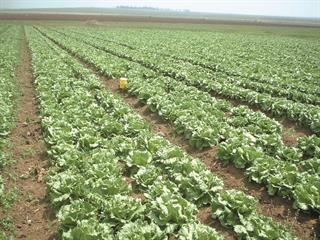
Back in the day, before cavity seedlings arrived on the scene, lettuce was directly sown, sometimes broadcast and usually planted in rows with a planter. To secure a good stand with a small seeded species (about one million seeds per kg), one had to spread one’s seed thickly and then do some thinning out while weeding.
The seed company I worked for would import 4t of seed a year. Nowadays a fraction of that is imported. In California, where the climate is mild, dry and predictable, direct sowing has continued. The lands are large and very flat, and with precision planting, special rolling cultivators remove weeds almost right up to the plant rows. After this, labour comes in with 20cm-wide hoes to thin out while weeding.
Secure good stand
In South Africa, with its thunderstorms, emergence is rather unpredictable. So, with smaller areas per land, farmers jumped at the opportunity to use cavity seedlings to secure a good stand. This cuts the time the crop has in the land by weeks. The next crop can follow sooner, which increases the profitability of the land.
Weed control is difficult with direct seeding because we don’t have good herbicides registered for this purpose. However, when using seedling plugs, you might have to deal with the Pythium fungus because the transplants are often roughly handled and also irrigated too late after transplanting.
The root hairs become damaged, so the pathogen enters the root system. Symptoms often manifest quite long after planting, but Pythium is less of a problem these days as farms have become larger and more professional. Another challenge with seedling plugs is J-rooting.
This occurs when seedlings are pushed into the soil or bent over during transplanting. Instead of the roots being orientated vertically, they are bent to one side, stunting the plant. So supervise your planters closely to ensure they set the seedling plugs properly into the soil. An ongoing problem with J-rooting often causes a farmer to switch to a mechanical planter.
Taken together, these factors show why direct seeding, despite its challenges, is a practice more suited to bigger farms – which can also better meet the increasing demand for prepacked lettuce through packhouse mechanisation.
A step forward
In California, farmers make use of contractors with specialised machinery for harvesting, which runs through the land with a team of workers in a line, cutting the lettuce and placing it on a conveyer. The lettuce is then wrapped, boxed and run along another conveyer to a waiting truck. This takes the lettuce to a vacuum chamber, where the air is sucked out, cooling the produce before it’s sent to market.
Now that’s what I call mechanisation! Another change in lettuce production is the availability of varieties better able to cope with heat or cold. In the past, when we had a hot spell in summer, lettuce on the Highveld would bolt and become unmarketable. By contrast, the modern varieties have been performing well, even in our current hot spell.
Cooler climes
Other new lettuce varieties thrive in cooler conditions, although nothing will go through the Highveld winters without damage. Here, you have to finish harvesting by mid-May. However, I suppose it’s only a matter of time before even newer varieties change this.
The problem with cold weather is that the heads become vulnerable to burn when firming up. So you can start off in frosty weather and then go into frost-free conditions for the latter half of the plants’ growth.











